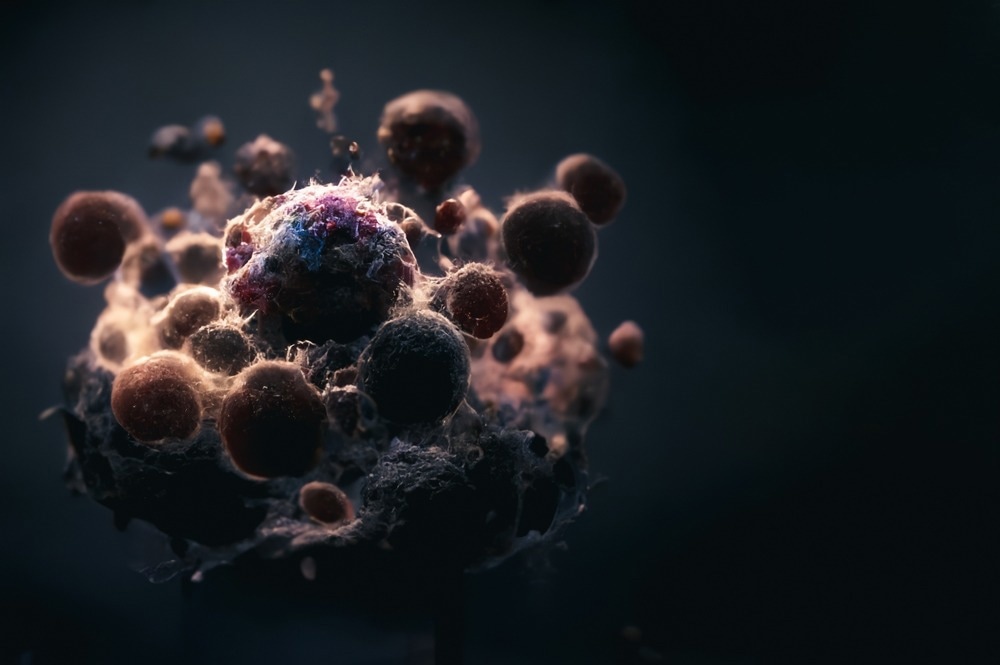In a recent article published in Nanomaterials, researchers investigated the potential of chitosan nanoparticles (CHNPs) as a delivery system for curcumin, aiming to improve its therapeutic efficacy against breast cancer.

Image Credit: CI Photos/Shutterstock.com
Background
Chitosan, a biopolymer obtained from chitin, is known for its biocompatibility, biodegradability, and ability to encapsulate various therapeutic agents. The ionic gelation method is a widely used technique for synthesizing chitosan nanoparticles, allowing for the formation of stable nanosuspensions. The incorporation of curcumin into chitosan nanoparticles is expected to enhance its solubility and bioavailability, thereby improving its anti-cancer effects.
While curcumin has been shown to induce apoptosis in cancer cells and inhibit tumor growth, its poor pharmacokinetic properties limit its clinical application.
The Current Study
To synthesize the CHNPs, tripolyphosphate (TPP) was used as a cross-linking agent, facilitating the ionic gelation of chitosan and resulting in nanoparticle formation. These CHNPs were then characterized using dynamic light scattering (DLS) to measure particle size and zeta potential. A zeta potential measurement was performed to assess nanoparticle stability in suspension, with values above +30 mV indicating good stability due to electrostatic repulsion.
To load curcumin into the chitosan nanoparticles, a specific weight ratio of curcumin to chitosan was established, and curcumin was encapsulated within the nanoparticles. The mixture was centrifuged to separate unencapsulated curcumin from the nanoparticle suspension. The supernatant was collected, and the amount of curcumin in the supernatant was quantified using UV-visible spectrophotometry to calculate encapsulation efficiency.
In vitro studies were conducted using breast cancer cell lines, which were cultured in a growth medium supplemented with fetal bovine serum (FBS) and antibiotics. The cytotoxicity of the curcumin-loaded CHNPs was assessed using the MTT assay, where cells were seeded in 96-well plates and treated with varying concentrations of free curcumin and Cur-CHNPs. Absorbance was measured at 570 nm using a microplate reader, and the percentage of cell viability was calculated.
For in vivo studies, male BALB/c mice were acclimatized for one week before the experiment. Breast cancer was induced by subcutaneously injecting the mice with a specific number of cancer cells. Once the tumors reached a predetermined size, the mice were randomly assigned to different treatment groups, including those receiving free curcumin and those receiving Cur-CHNPs. The treatments were administered orally, with dosages calculated based on the mice's body weight.
Tumor growth was monitored by measuring the dimensions of the tumors. Hematological and biochemical parameters were evaluated to assess the safety and toxicity of the treatments. Blood samples were collected, and various assays were conducted to analyze liver and kidney function, as well as complete blood counts.
Results and Discussion
Physicochemical characterization revealed that the optimized chitosan nanoparticles were approximately 85 nm in size, while the curcumin-loaded nanoparticles measured around 118 nm. The positive zeta potential, which is favorable for cellular uptake, indicated that the nanoparticles were well-suited for therapeutic use.
The study demonstrated that Cur-CHNPs had enhanced solubility in aqueous solutions compared to free curcumin, suggesting improved bioavailability. Long-term stability assessments showed that the nanoparticles maintained their size without aggregation over 74 days, highlighting their potential for sustained release applications.
In vitro studies indicated that Cur-CHNPs significantly inhibited the proliferation of breast cancer cells more effectively than free curcumin. This effect was attributed to the induction of apoptosis and cell cycle arrest, which were confirmed through various assays.
In vivo experiments supported these findings, showing a marked reduction in tumor volume in mice treated with Cur-CHNPs compared to control groups. The study also assessed the acute and subchronic toxicity of Cur-CHNPs, revealing no significant adverse effects on the hematological and biochemical parameters of the treated mice. These results underscore the safety and efficacy of chitosan nanoparticles as a delivery system for curcumin in breast cancer therapy.
The ability of Cur-CHNPs to enhance curcumin's solubility and bioavailability presents a promising approach to overcoming the limitations associated with traditional curcumin administration. The study also highlighted the potential of chitosan nanoparticles as a versatile platform for delivering other therapeutic agents, paving the way for future research in this area.
Conclusion
In conclusion, the in vitro and in vivo results indicate that Cur-CHNPs not only suppress tumor growth but also exhibit a favorable safety profile, making them a promising candidate for further development in cancer therapy.
This research supports the use of nanotechnology in improving drug delivery systems, particularly for compounds with limited clinical applicability. Future studies are required to explore the long-term effects and potential clinical applications of Cur-CHNPs for various cancer types.
Journal Reference
Mishra B., et al. (2024). Chitosan Nanoparticle-Mediated Delivery of Curcumin Suppresses Tumor Growth in Breast Cancer. Nanomaterials. DOI: 10.3390/nano14151294, https://www.mdpi.com/2079-4991/14/15/1294